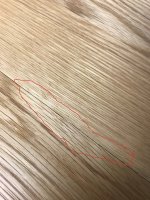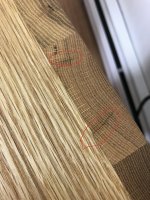Yes, that will work as long as you balance it, that is, thick veneer on both sides. Thick being 1/8" - 3/16" on minimum 1/2" substrate, 3/4" preferred. And probably on plywood as I had some 1/8" birds eye maple on 1/2" MDF that actually started to split the MDF. Thankfully, that hadn't been used to make anything.Better off cutting hardwood into thick veneers and gluing it to a suitable substrate
bmc0 is correct. It is all in the way you design the cabinet. Design it properly so the wood can move across the grain then you can build with solid wood, or wood panels and not have any problems. Joins can be done with rubber seals or a flexible glue. I have made speaker cabinets from solid woods many times, the oldest would now be over 15 years old and is still fine. No splits, no gaps on any of the cabinets. It does help if the cabinet is tall and slim and if the wood is quarter sawn. My cabinets are glued top, bottom and sides with the grain going lengthwise. The baffle and back are screwed on (not too tight) with a rubber seal to make it air tight. This argument comes up from time to time with some saying no you can't, others say yes you can. I say yes you can, and have proven it can be done successfully.
This way is fine ... problem is most don't do it like this. Most trap the front and back to the main case or turn the grain for the top or bottom and that's when the fun starts. There's a way to edge glue solids that helps to keep the ends from checking over extended lifetime but the way is "old school". I'm 100% sure, no such technique was used in fabricating the product the OP'er shows here. Main take away is trapping solid panels in case construction is not wise.bmc0 is correct. It is all in the way you design the cabinet. Design it properly so the wood can move across the grain then you can build with solid wood, or wood panels and not have any problems. Joins can be done with rubber seals or a flexible glue. I have made speaker cabinets from solid woods many times, the oldest would now be over 15 years old and is still fine. No splits, no gaps on any of the cabinets. It does help if the cabinet is tall and slim and if the wood is quarter sawn. My cabinets are glued top, bottom and sides with the grain going lengthwise. The baffle and back are screwed on (not too tight) with a rubber seal to make it air tight. This argument comes up from time to time with some saying no you can't, others say yes you can. I say yes you can, and have proven it can be done successfully.
They look great. Did you use the lam oak with the grain running vertically on all vertical sides?Last year I built two projects from 1" thick laminated oak boards.
Where did they crack?The only slight issue I had was some minor cracking which developed in the dry winter months.
Maybe look at marine grade epoxy resin to seal the wood. All surfaces would need to be sealed. Screw holes too!I used a danish oil finish which probably wasn't heavy enough to prevent the wood from further drying. I think a varnish finish would avoid this.
👍Otherwise, the laminated oak is very rigid, quite heavy, and it does sound good. It's also nice to not worry about ruining the thin veneer that's found on plywood.
The last years I preferred to use polurethane wood glue (D4 or Class 40) instead conventional, water resistant PVA glue (D3 or Class 30).
As it foams a little while drying (needs minimal moisture for the process), if gives much better bonds and fills small gaps. Because of the foaming, you have to press it until cured or it may move. Curing takes about 15 minutes at room temperature. I use a water spray bottle, to put some very fine mist on the wood, before joining it. It speeds up curing, as usually we use very dry wood products.
I have not tried this special task by my self yet, but it does not crack under load, like hardened PVA glue, but stays a little bit elastic, I would use it for bonding natural wood to a substrate of particle or ply boards. The elasticity should be more suited to deal with the "working" of real wood.
As it foams a little while drying (needs minimal moisture for the process), if gives much better bonds and fills small gaps. Because of the foaming, you have to press it until cured or it may move. Curing takes about 15 minutes at room temperature. I use a water spray bottle, to put some very fine mist on the wood, before joining it. It speeds up curing, as usually we use very dry wood products.
I have not tried this special task by my self yet, but it does not crack under load, like hardened PVA glue, but stays a little bit elastic, I would use it for bonding natural wood to a substrate of particle or ply boards. The elasticity should be more suited to deal with the "working" of real wood.
Thank you. Yes, I used the same laminated oak for all parts with vertical grain on all sides.They look great. Did you use the lam oak with the grain running vertically on all vertical sides?
Photos below. One lamination seam opened up about 0.010" on the outer surface only. Two other cracks on the end grain of one board. All reverted a lot after winter was over and the humidity increased. The two on the end are closed now and not really noticeable.Where did they crack?
Thanks. I will look into a marine grade finish and possibly some humidity control.Maybe look at marine grade epoxy resin to seal the wood. All surfaces would need to be sealed. Screw holes too!
Attachments
Photos below
Thanks for the high definition photos and circling the cracks as I wouldn't have seen them otherwise! I cant see marine epoxy being worth it for these speakers now they are finished. On the oher hand the humidity control in winter might make you more comfortable and look after the speakers as a side benefit.
The speakers look great. The natural wood grain is beautiful. Thanks for sharing.
Wow……i might have to ask the local builders if they need a source because i can get kiln dried and sized red oak for $3 bf , already have all the equipment….. could whack these out for half that price and still make good money!In case anybody's interested, this is the stuff I used...
https://www.homedepot.com/p/Stairte...shed-Red-Oak-Tread-BTRO1142/202019901#overlay
I had to glue some together to get the width needed for the subs.
Some examples of Bernie’s work in solid. All edge laminated solid wood sheets.
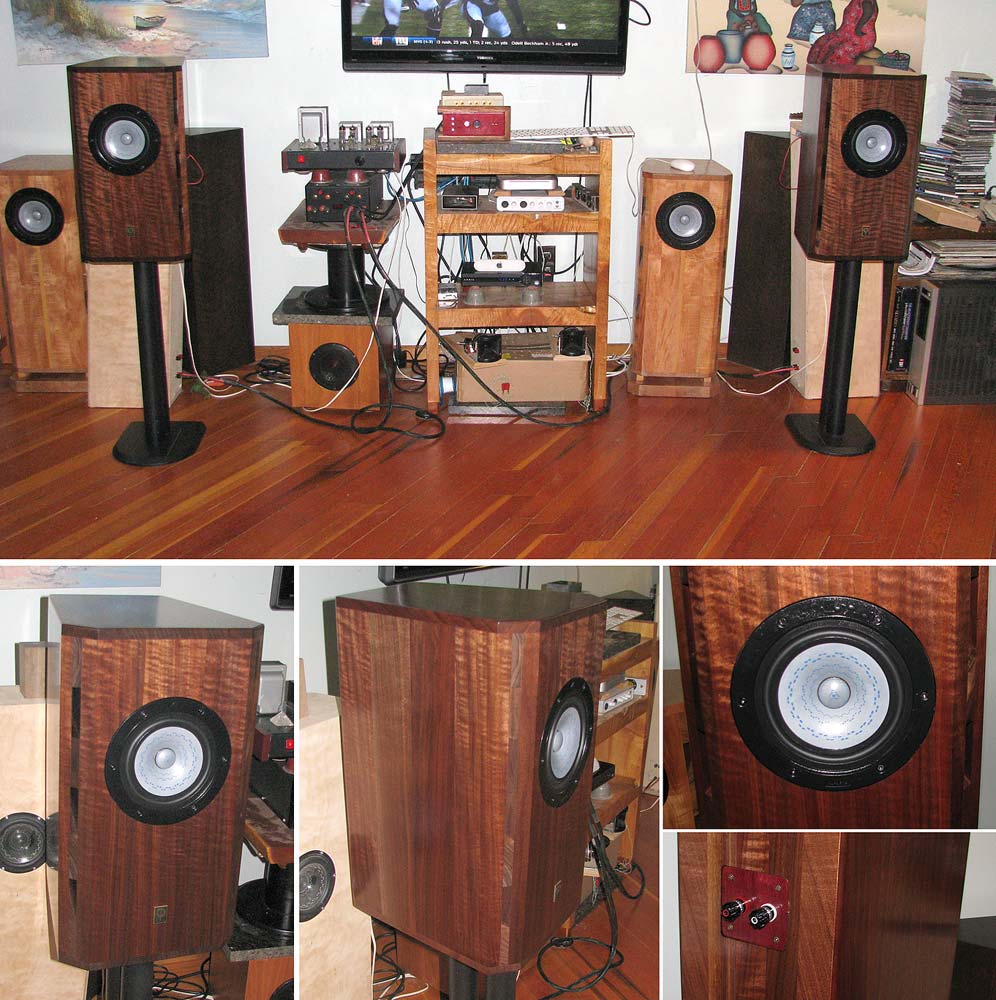


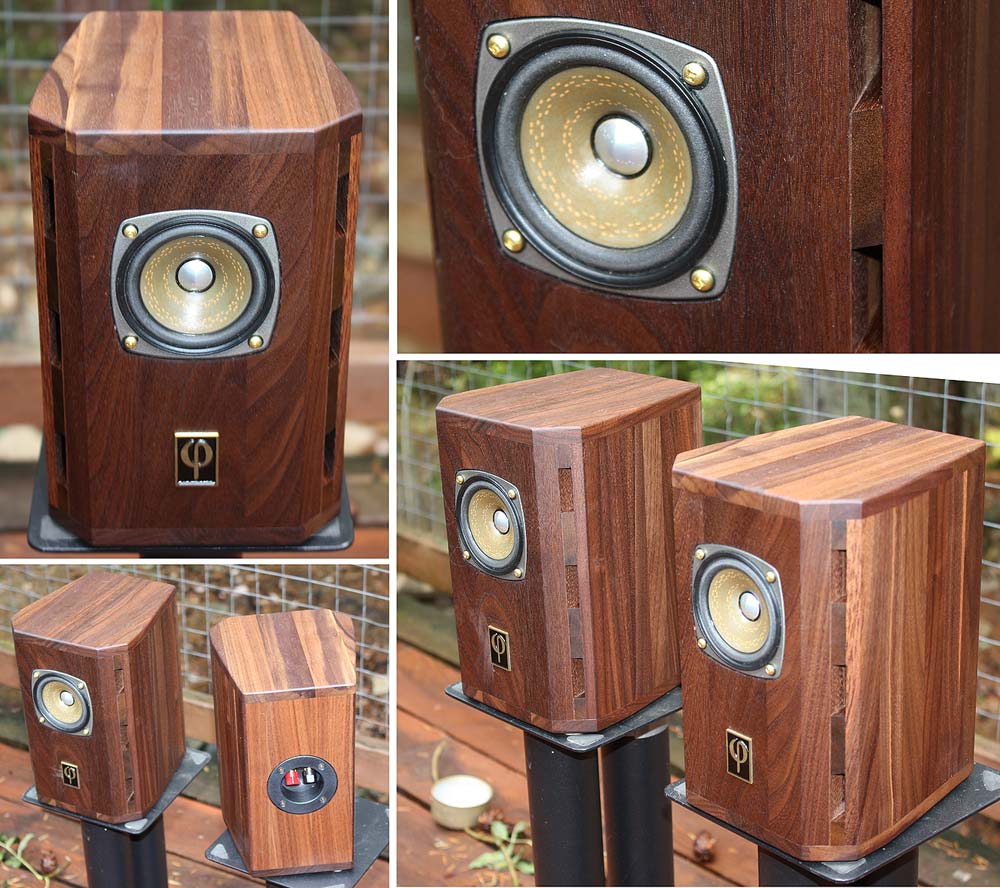
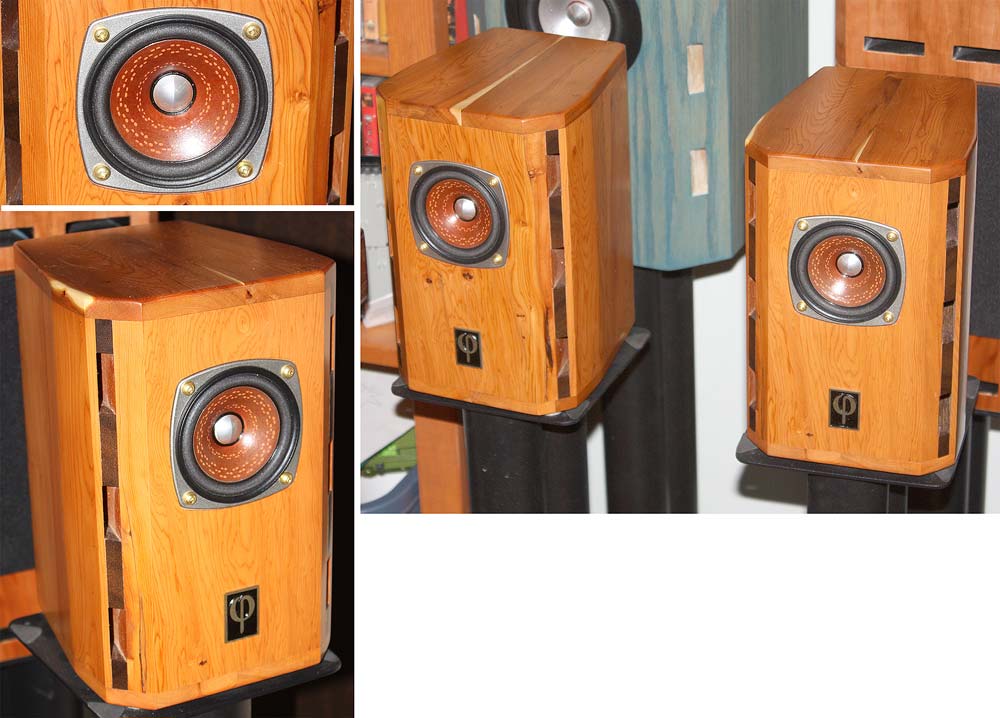



and Nick’s:

dave








and Nick’s:
dave
Some relevant experience and advice in this thread. I’m still happy with the project.
https://www.diyaudio.com/community/...lestion-ftx1225-ongoing-advice-needed.377105/

https://www.diyaudio.com/community/...lestion-ftx1225-ongoing-advice-needed.377105/
Last edited by a moderator:
The benefits of quarter-sawn timber have already been discussed above. Properly cured and joined, hardwood panel glue-ups don't typically shift too much if they are put in the average climate controlled home. Three points:
1) this thread should be titled "solid wood", not "hardwood", as the OP originally posted about an engineered softwood product (at least the original photo in post #1). Big difference between softwood and hardwood species.
2) I'm a fan of OSMO Top oil, a bit of a hybrid oil/wax. It is relatively non-toxic and provides a beautiful finish. It will also fill tiny gaps in joinery like those shown in post #26 with a simple 30 second reapplication when necessary -- no need to take it outside to de-gass or to panic over natural and minimal wood movement.
3) I have used marine epoxies and sealants to build a wooden boat. Toxic stuff. Significant precaution needs to be taken when applying and drying. I personally wouldn't use this for speakers that go in the house. Very much overkill.
YMMV.
1) this thread should be titled "solid wood", not "hardwood", as the OP originally posted about an engineered softwood product (at least the original photo in post #1). Big difference between softwood and hardwood species.
2) I'm a fan of OSMO Top oil, a bit of a hybrid oil/wax. It is relatively non-toxic and provides a beautiful finish. It will also fill tiny gaps in joinery like those shown in post #26 with a simple 30 second reapplication when necessary -- no need to take it outside to de-gass or to panic over natural and minimal wood movement.
3) I have used marine epoxies and sealants to build a wooden boat. Toxic stuff. Significant precaution needs to be taken when applying and drying. I personally wouldn't use this for speakers that go in the house. Very much overkill.
YMMV.
Yes, I know these are pricey compared to solid boards. The cost is due to the lamination, so it's simply not the same thing. Use of laminated was my intention from the begining and the price of the stair treads was better than similar material from other sources beacuse of no shipping charges or minimum buys.Wow……i might have to ask the local builders if they need a source because i can get kiln dried and sized red oak for $3 bf , already have all the equipment….. could whack these out for half that price and still make good money!
Big difference between softwood and hardwood species
Big differences between species. The builds shown above are both hardwood (deciduous) and softwood (conifer)
From the POV of cabinet integrity one of the best are the western red cedar µFonken. The downside is how easily it is bruised. The big ones are Douglas Fir (a pine), old growth aged for 70 years as Bernie’s floor. The Mar-Kem70T are as well. The Compact Floorstander Mar-Kel70 are yellow cedar.
Others are locust, yew, black walnut, mahogany, and oak.
The ones that most impressed are the cedar ones. Need old growth thou.
dave
I've build enclsures from these shelves, used beech and pine (!!!, it will shrink and expand, watch the grain direction). These panels do work a little (depending on how much the humidity changes in your home) and you'll want to use a glue that will allow some movement. This means expoxy is out. You can use one of the PVA glues but if a joint breaks open then you are in trouble as it will not take to the same glueline again.
I only used hide glue (my speaker making days are over): It will allow movement and if needed you can dissasemble and re-glue. This is what has been done and used for hundreds of years on musical instruments. It dates back to the time of the Pharaos in Egypt and there are items in museums that were glued in that time and today are still tightly glued together, thousands of years later.
I only used hide glue (my speaker making days are over): It will allow movement and if needed you can dissasemble and re-glue. This is what has been done and used for hundreds of years on musical instruments. It dates back to the time of the Pharaos in Egypt and there are items in museums that were glued in that time and today are still tightly glued together, thousands of years later.
Last edited:
I've built a few hard wood cabinets. I've used plywood edged with solid wood many times.
I usually buy 20-30 stair flats from Mr. Big Box and clamp lots of 10 for 2-3 years in my shops. I rotated inside to outside every 3 months or so. I have apitong that was 1x6x120" that was clamped for over 30 years. It is the most stable wood I know of AFTER curing. It is self sealing because of the heavy resin content. It stinks too.
Everything I use is cured for over a year, even if it's MDF. The only issue with really dry hard wood requires water cooling for any intricate cuts on a CnC. I'm pretty old fashion I use to use, a duplication machine with templates for
driver baffle design, pipes, a few middle finger book ends.
I've also take stair flats, cut and fit with biscuits and used them for wide baffle designs too. They don't move if they are cured and sealed.
I'm in Northern CA. It gets HOT and dry in the summer. We have fast and sometimes wet winters. The wood can cure. In the gulf regions I'm not sure you could get wood dry enough, East coast either. Deserts are good, you have to add moisture to the cure though.
I use to build lattice columns out of 3/4" chocolate apitong. The drivers, lattice, and stand were heavy (90lb ea.) That 3/4" square stock is still as straight as an arrow 15 years later.
The moral of my story is; CURING is the key to all things wood. Including cannabis and my favorite Vanilla beans.
Regards
I usually buy 20-30 stair flats from Mr. Big Box and clamp lots of 10 for 2-3 years in my shops. I rotated inside to outside every 3 months or so. I have apitong that was 1x6x120" that was clamped for over 30 years. It is the most stable wood I know of AFTER curing. It is self sealing because of the heavy resin content. It stinks too.
Everything I use is cured for over a year, even if it's MDF. The only issue with really dry hard wood requires water cooling for any intricate cuts on a CnC. I'm pretty old fashion I use to use, a duplication machine with templates for
driver baffle design, pipes, a few middle finger book ends.
I've also take stair flats, cut and fit with biscuits and used them for wide baffle designs too. They don't move if they are cured and sealed.
I'm in Northern CA. It gets HOT and dry in the summer. We have fast and sometimes wet winters. The wood can cure. In the gulf regions I'm not sure you could get wood dry enough, East coast either. Deserts are good, you have to add moisture to the cure though.
I use to build lattice columns out of 3/4" chocolate apitong. The drivers, lattice, and stand were heavy (90lb ea.) That 3/4" square stock is still as straight as an arrow 15 years later.
The moral of my story is; CURING is the key to all things wood. Including cannabis and my favorite Vanilla beans.
Regards
For Bernie and Nick (apologize but I don't know if they are posters here to tag), first, those are beautiful.Some examples of Bernie’s work in solid. All edge laminated solid wood sheets.


and Nick’s:

dave
Some of these designs seem to date back to the early 2010's, have they faired well (especially if that radiator is the functional heating system)?
Do they have any tips/methods on how they may have addressed the wood expansion, specifically where the tops and sides meet (it appears the top grain is aligned to the front grain and so the greatest expansion will match (side to side), but the sides' greatest expansion would seem to be front to back while tied to the location where the top would experience it's lowest expansion)?
Some lifestyle choices effectively negate any practical form of a humidity controlled environment right now, so for me, wood movement is not a minor concern (the first winter we lived here we had a door effectively wedged shut in the frame).
However, it's not like things get up and walk across the floor. For context, 6"-12" widths estimate* out to .03-.14" (0.8-3.6 mm) for White Oak (higher), .03-.08" (0.8-2 mm) for Walnut, and .02-.05" (0.5-1.3 mm) for Eastern Red Cedar (lower).
*using the https://kmtools.com/pages/wood-movement-calculator based on the USDA Forest Products Laboratory Wood handbook https://www.fs.usda.gov/research/treesearch/37440
I did not make that connection. I didn't read up on that until after I finished most of my furniture projects, so I don't have any experience. Did you make your own? How hard a rap does it take to break the joint free? I expect if a bookshelf speaker falls off the shelf, that's probably going to do it. I guess it's like a crumple zone though, and the alternative is component damage (vice a pile of parts you can re-assemble).... hide glue (my speaker making days are over): It will allow movement and if needed you can dissasemble and re-glue. This is what has been done and used for hundreds of years on musical instruments. It dates back to the time of the Pharaos in Egypt and there are items in museums that were glued in that time and today are still tightly glued together, thousands of years later.
- Darrell
I can’t speak for Nick's but the ones i have from Bernie have held up. He did need to do a bit of remediation on my Yew µFonken, as well as a set of highly abused garry oak.
Scott had a crack he had to fix in one of his yellow cedar builds.
dave
Scott had a crack he had to fix in one of his yellow cedar builds.
dave
Last edited:
Hide glue, and fish glues should be available from a good wood work supplier (Lee Valley in Canada & the US). Fine Woodworking tests showed that neither was, in practical terms, any less strong than a good PVA glue, and certainly on par, or better than, some of the urethane glues. (Thinking Gorilla, not the construction adhesives). I use fish glue regularly (no, it doesn't smell) as any squeeze out can be cleaned up with a tooth brush, water, and a rag.For Bernie and Nick (apologize but I don't know if they are posters here to tag), first, those are beautiful.
Some of these designs seem to date back to the early 2010's, have they faired well (especially if that radiator is the functional heating system)?
Do they have any tips/methods on how they may have addressed the wood expansion, specifically where the tops and sides meet (it appears the top grain is aligned to the front grain and so the greatest expansion will match (side to side), but the sides' greatest expansion would seem to be front to back while tied to the location where the top would experience it's lowest expansion)?
Some lifestyle choices effectively negate any practical form of a humidity controlled environment right now, so for me, wood movement is not a minor concern (the first winter we lived here we had a door effectively wedged shut in the frame).
However, it's not like things get up and walk across the floor. For context, 6"-12" widths estimate* out to .03-.14" (0.8-3.6 mm) for White Oak (higher), .03-.08" (0.8-2 mm) for Walnut, and .02-.05" (0.5-1.3 mm) for Eastern Red Cedar (lower).
*using the https://kmtools.com/pages/wood-movement-calculator based on the USDA Forest Products Laboratory Wood handbook https://www.fs.usda.gov/research/treesearch/37440
I did not make that connection. I didn't read up on that until after I finished most of my furniture projects, so I don't have any experience. Did you make your own? How hard a rap does it take to break the joint free? I expect if a bookshelf speaker falls off the shelf, that's probably going to do it. I guess it's like a crumple zone though, and the alternative is component damage (vice a pile of parts you can re-assemble).
- Darrell
I've not heard of hide glue used on speaker cabinets, but this is a supplier I've used for musical instruments. He has many grades and some good info. I recall there was even more info decades ago, surely findable through archive.org.
https://bjornhideglue.com
https://bjornhideglue.com
Thanks, planet10, prairieboy, and benb!
I think I will try it, I wish I had known about it for the last set of chairs.
I think I will try it, I wish I had known about it for the last set of chairs.
- Home
- Loudspeakers
- Multi-Way
- Laminated hardwood for speaker cabinets
